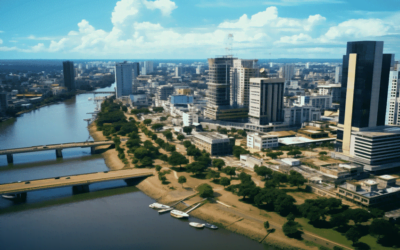Hey there, fellow drone enthusiasts and curious minds! I get it – you’re here because you’re intrigued by the world of drones and you want to understand the nitty-gritty of Hungary’s drone laws.
Maybe you’re a drone hobbyist eager to spread your wings (or rotors) in this captivating country, or perhaps you’re a professional drone operator seeking clarity in this ever-evolving regulatory landscape. No matter your background or reason, you’ve got questions, and I’m here to provide answers.
Well, let me assure you, I’ve done my homework. I’ve delved into the labyrinth of Hungary’s drone laws, scoured official documents, and chatted with experts in the field.
This article is the result of that exploration. I’ve mapped out the regulations, their categories, operational rules, and much more. So, if you’re searching for a clear, well-researched guide to Hungary’s drone laws, you’re in the right place. I’ve got the answers, and I’m excited to share them with you.
If you’re looking for a roadmap through Hungary’s drone regulations or simply want to stay informed about the latest updates, you’re in for a treat. In the pages that follow, we’ll navigate the skies of Hungary’s drone laws together.
I’ll break down the rules and categories, discuss safety measures, explore no-fly zones, and even touch on commercial drone operations.
So, buckle up (or rather, prop up your drone) and read on, because, by the end of this journey, you’ll be well-equipped to navigate the drone-filled skies of Hungary while adhering to the law. Let’s soar into it!
- Registration and Classification of Drones
- Operational Rules and Restrictions
- Remote Identification and Tracking
- Licensing and Training Requirements
- No-fly Zones and Restricted Areas
- Insurance Requirements
- Commercial Drone Use
- Penalties and Consequences
- Updates and Changes
- Final Thoughts on Hungary Drone Laws
- Frequently Asked Question
Registration and Classification of Drones

So, let’s start at the very beginning – understanding how Hungary classifies drones. It’s like sorting them into different boxes, each with its own set of rules. These categories are typically based on the weight and capabilities of the drones. Trust me; it’s simpler than it sounds.
Category A: Feather-Light Fliers
Category A, our lightest box, is for drones that weigh less than 250 grams. These drones are like the hummingbirds of the drone world, small and nimble.
If you’re a casual flyer with one of these, you’re in the clear in terms of the most stringent regulations. However, always remember, that even small drones can cause issues if flown carelessly.
Category B: The Midweight Champions
Category B is where most drones fit. It’s for the drones that weigh between 250 grams and 25 kilograms.
This is the versatile category, embracing a wide range of drones, from your nifty photography drones to those used for more professional work. As you’d expect, this category has its own set of rules that we’ll dive into.
Category C: The Heavy Hitters
Now, Category C is for the heavyweights. These are the drones that tip the scales at over 25 kilograms. You don’t come across these giants every day.
These drones are typically used for industrial purposes, and they carry a lot of responsibility. We’ll touch on the regulations for these robust drones in a bit.
The Registration Process: No Papers, No Fly
Now, you might wonder, how do you get your drone into one of these categories, and what’s with all this talk about registration? Well, here’s the deal: it’s essential to register your drone with the Hungarian National Transport Authority (NKH) if you’re flying a drone in Hungary.
Think of it like getting your driver’s license; it’s just one of those things you’ve got to do. The registration process helps the authorities keep track of drones and ensures that you’re aware of the rules in place for safe and responsible drone flying.
We’ve got the categories and registration process outlined for you, and we’re just getting started. It’s time to roll up our sleeves and delve into the specifics. Ready? Let’s go!
Also Read: Drone Regulations in Honduras 2024
Operational Rules and Restrictions

Now that we’ve got the categories sorted, let’s dive into the rules and restrictions that guide the skies of Hungary. Trust me; it’s not just about pushing the throttle and soaring. There are a few things you need to keep in mind to fly your drone safely and responsibly in this country.
Visual Line of Sight (VLOS): Keeping an Eye on Things
First, is the Visual Line of Sight (VLOS) requirement. It’s pretty simple: always keep your drone in your line of sight. It’s like playing hide and seek with your drone.
Flying beyond your line of sight is a no-go unless you have specific authorization. So, if you thought about sending your drone on a long-distance adventure, you might want to reconsider.
The No-Fly Zones: Steer Clear of Trouble
Flying over people, crowds, and sensitive areas is another thing you need to watch out for. You wouldn’t want your drone creating panic at a public event, right? Keep it away from people and gatherings.
Plus, when it comes to sensitive areas like government buildings and industrial sites, it’s better to steer clear. Safety and privacy are paramount.
Respect for Privacy and Property Rights: The Neighborly Thing to Do
Privacy is essential, and that’s why you need to be respectful while flying your drone. Don’t be that person buzzing over someone’s backyard without permission. Respect people’s privacy, property, and space. It’s the neighborly thing to do, and it keeps you on the right side of the law.
Altitude Limits: Staying Below 120 Meters
Next, there’s a cap on how high you can take your drone. The maximum altitude you can reach is 120 meters above ground level. That’s about 400 feet in the old lingo. It’s high enough for most recreational and professional drone activities, but remember, the sky isn’t limitless, and we have to share it responsibly.
Restricted Airspace: Know Where Not to Fly
Avoid flying near airports, airfields, and restricted airspace. It’s not only dangerous but also illegal. You don’t want to be that person who disrupts air traffic or ends up in a no-fly zone. Stay informed about these restricted areas, and you’ll be well on your way to safe drone operation.
Controlled Airspace: Gaining Permission to Soar
Lastly, if you’re thinking about flying in controlled airspace, you’ll need proper authorization. Controlled airspace is, well, controlled for a reason. You’ll have to navigate through the official channels to get permission. We’ll dig deeper into this process shortly.
We’ve got our operational rules and restrictions laid out, and there’s more to explore. So, fasten your seatbelt (or rather, secure your drone) because we’re in for an adventure through Hungary’s drone laws!
Also Read: Drone Regulations in Haiti 2024
Remote Identification and Tracking

So, you’re all set to take your drone for a spin in Hungary, but have you ever wondered how the authorities keep tabs on these flying machines? Well, that’s where remote identification systems come into play. Let’s demystify this important aspect of drone regulation.
Remote Identification Systems: The Digital Name Tag
Remote identification systems are like digital name tags for your drone. They are designed to provide vital information about your drone while it’s in the air.
This information typically includes your drone’s registration number, its current location, and its operator’s details. It’s a bit like your drone’s digital ID card, allowing authorities to identify and track it during its flight.
Tracking and Identification: Keeping Skies Safe
Remote identification isn’t just a fancy feature; it’s a crucial safety measure. Imagine a situation where a drone suddenly goes rogue and interferes with manned aircraft or flies into a restricted area. Remote identification helps authorities quickly identify the operator and the drone itself. This enables them to take appropriate action to ensure the safety of the skies and everyone on the ground.
With the role of remote identification systems clarified, you now have a better understanding of how drones are monitored in Hungary. But there’s more to explore, so stay with us as we journey deeper into the realm of Hungary’s drone laws.
Also Read: Drone Regulations in Guyana 2024
Licensing and Training Requirements

Okay, here we go – diving into the world of licensing and training for drone operators in Hungary. It’s not as complicated as it might sound, and it’s a crucial part of keeping our drone-filled skies safe and responsible.
Overview of Licensing and Training: The Essentials
So, you’re thinking of operating a drone in Hungary? Whether it’s for recreation or commercial purposes, there are certain licensing and training requirements you need to be aware of. These regulations are in place to ensure that drone operators have the necessary knowledge and skills to fly safely and responsibly.
Recreational vs. Commercial Use: Know the Difference
Now, it’s essential to distinguish between recreational and commercial drone use. If you’re flying your drone purely for fun and aren’t making any money from it, you’re in the recreational category.
However, if you’re using your drone for any kind of economic gain or professional services, such as photography or surveying, you’re considered a commercial operator. Each category may have different licensing and training requirements, so it’s vital to understand where your drone activities fall.
With the basics of licensing and training requirements clarified, you’re better prepared to navigate Hungary’s drone laws. But hang tight, because we’re about to explore even more aspects of drone regulation in Hungary.
Also Read: Drone Regulations in Guinea-Bissau 2024
No-fly Zones and Restricted Areas

It’s time to get acquainted with the places you shouldn’t be flying your drone in Hungary. We’re talking about the no-fly zones and restricted areas. Understanding these spaces is vital for safe and responsible drone operation.
No-fly Zones: Where Drones Must Stay Grounded
Hungary, like many other countries, designates specific no-fly zones where drones are strictly prohibited. These zones are typically around airports, heliports, and other critical aviation infrastructure.
The logic here is straightforward – we don’t want drones causing interference with manned aircraft, which could lead to dangerous situations. So, if you’re near one of these no-fly zones, it’s best to keep your drone safely grounded.
Restricted Areas: Protecting Sensitive Spaces
Besides the no-fly zones, Hungary also has restricted areas where drone flights are prohibited. These areas can encompass various spaces, from government buildings to industrial sites.
The idea is to protect sensitive locations and ensure that drone operations don’t compromise security or privacy. Staying informed about the specific restricted areas in Hungary is crucial to avoid legal trouble and contribute to the overall safety of the skies.
We’ve just scratched the surface of Hungary’s no-fly zones and restricted areas. There’s more to explore, so let’s keep moving and discover additional aspects of drone regulations in Hungary.
Also Read: Drone Regulations in Guinea 2024
Insurance Requirements

Let’s talk about an essential aspect of drone operation: insurance. Whether you’re flying for fun or business, having the right insurance can save you from potential headaches and financial burdens.
Liability Insurance: A Safety Net
Liability insurance is a must-have for drone operators. It’s like a safety net in case something goes wrong during your flight.
This type of insurance covers damages and accidents that your drone might cause to people or property. Accidents can happen to even the most careful operators, so having liability insurance provides peace of mind and ensures that you’re financially protected in case of any mishaps.
Coverage for Damages and Accidents: How it Works
So, how does this insurance work? In case your drone causes damage or an accident, your liability insurance steps in to cover the costs.
This could include compensation for injuries to others, property damage, or legal fees. Without insurance, you could be personally liable for all these expenses, which could be substantial. Having the right insurance ensures that you’re prepared for the unexpected and keeps your drone operations worry-free.
Now that you know the importance of insurance, you’re better equipped to navigate the legalities and responsibilities of drone operations in Hungary. Stay with us as we uncover more essential aspects of drone regulations in this captivating country.
Also Read: Drone Regulations in Guatemala 2024
Commercial Drone Use

Now, let’s talk about the exciting world of commercial drone use in Hungary. If you’re running a business and looking to elevate your services with drones, there are a few essential steps and considerations you need to be aware of.
Obtaining Permits and Licenses: The Paperwork
For businesses planning to use drones in Hungary, permits and licenses are a must. It might sound like bureaucracy, but it’s all about ensuring safety and responsibility.
You’ll need to go through the proper channels, usually involving the Hungarian National Transport Authority (NKH), to obtain the necessary permits. These permits outline the specifics of your drone operations, including the areas and altitudes you’re allowed to fly in.
Compliance with Regulations: The Key to Success
Why is compliance so crucial for businesses using drones? Well, it’s not just about following the rules; it’s about establishing trust and a good reputation. When you comply with regulations, you’re not only avoiding legal issues but also ensuring the safety of your clients, your employees, and the public.
Complying with the rules demonstrates that you’re a responsible and trustworthy business operator, which can go a long way in building your brand and customer trust.
Commercial drone use offers exciting opportunities, but it’s vital to get your paperwork in order and stay within the regulations. Now, with these insights, you’re better prepared to take your business to new heights in Hungary while ensuring a safe and compliant operation. Let’s keep exploring more about the dynamic world of drone regulations in Hungary.
Also Read: Drone Regulations in Grenada 2024
Penalties and Consequences

Now, let’s take a look at something no one wants to encounter but is essential to understand – the penalties and consequences for violating drone regulations in Hungary. Knowledge is power, and in this case, it’s also your ticket to avoiding legal trouble.
Potential Penalties: The Cost of Violations
If you break the rules and regulations set for drone operation in Hungary, you could face penalties. These penalties can range from fines to more severe legal consequences. The exact penalties can vary depending on the nature and severity of the violation, but they’re there to ensure that drone operators take the rules seriously.
Legal Consequences: Why Compliance Matters
Why does compliance matter so much? Well, not only does it keep you on the right side of the law, but it also ensures safety and security for everyone involved.
Violating drone regulations could lead to accidents, damage to property, or breaches of privacy. These are consequences no one wants to deal with, so it’s in everyone’s interest to follow the rules.
Understanding the potential penalties and consequences associated with drone operation in Hungary is essential for staying on the right side of the law and enjoying your drone hobby or business without any legal hiccups.
With these insights, you’re better equipped to navigate the sometimes complex legal landscape of drones. Stick around as we uncover more about Hungary’s drone laws and how to fly safely and responsibly.
Also Read: Drone Regulations in Greece 2024
Updates and Changes

One thing to always keep in mind in the world of drone regulations is that they are anything but static. They tend to evolve, much like technology itself. It’s crucial to recognize the dynamic nature of these rules and the need to stay informed.
Dynamic Regulations: Rolling with the Changes
Drone regulations can change in response to various factors, including technological advancements, safety concerns, and evolving airspace management. What was perfectly legal yesterday might have different rules today.
It’s not about making things complicated; it’s about ensuring safety and responsible drone operation. So, as a drone operator, it’s essential to keep an eye on updates and be ready to adapt to new requirements.
Checking with the Hungarian National Transport Authority: Your Best Bet
When you’re looking for the most current information on drone regulations in Hungary, the Hungarian National Transport Authority (NKH) is your best friend.
They are the official source for the latest updates and changes in drone laws. Regularly checking with them and staying informed about the most recent developments is your key to staying on the right side of the law and ensuring safe and responsible drone operation.
In the dynamic world of drone regulations, staying informed is your best strategy. With the information from the Hungarian National Transport Authority at your fingertips, you can continue to enjoy your drone adventures while staying compliant with the most up-to-date rules. Stick around as we explore more about the ever-evolving world of Hungary’s drone laws.
Also Read: Drone Regulations in Ghana 2024
Final Thoughts on Hungary Drone Laws

And there you have it, a comprehensive journey through Hungary’s drone laws, where we’ve covered everything from classifications to insurance, and penalties to staying informed. Let’s take a moment to sum it up.
We started by delving into the categorization of drones, which helps outline the rules and responsibilities associated with them.
We discussed the importance of registering your drone and understanding which category it falls into.
Then, we explored the operational rules and restrictions, emphasizing the significance of VLOS, respecting privacy, and steering clear of no-fly zones. We also highlighted the importance of insurance for both recreational and commercial drone operators.
Moving forward, we learned about the distinctions between recreational and commercial drone use and the significance of compliance with regulations, especially in the commercial sector.
We also touched on the critical aspect of remote identification and tracking, which enhances safety and security. Finally, we discussed the consequences of violating drone laws and emphasized the necessity of staying informed about updates through the Hungarian National Transport Authority.
As we wrap up, I want to stress the importance of responsible drone operation. Adhering to Hungary’s drone laws isn’t just about following rules; it’s about ensuring safety, security, and respect for others.
Whether you’re a hobbyist enjoying the skies or a business professional using drones for various services, your compliance matters. It keeps our skies safe and maintains the trust of the public.
Remember, the world of drone regulations is dynamic, and staying informed is your best strategy.
So, whether you’re flying for fun or business, let’s continue to explore the skies of Hungary responsibly and make the most of this incredible technology while respecting the rules that keep us all safe. Happy flying!
Also Read: Drone Regulations in Germany 2024
Frequently Asked Question
1. Can I fly a drone in Hungary without registering it?
No, all drones must be registered with the Hungarian National Transport Authority (NKH) before flying. Registration helps authorities track drones and ensures responsible operation.
2. What are the weight categories for drones in Hungary?
Drones are categorized into three classes: Category A (under 250 grams), Category B (250 grams to 25 kilograms), and Category C (over 25 kilograms). Different rules and requirements apply to each category.
3. Are there specific no-fly zones in Hungary?
Yes, Hungary designates no-fly zones around airports, heliports, and other critical aviation infrastructure to avoid interference with manned aircraft. Flying in these zones is strictly prohibited.
4. What are the insurance requirements for drone operators in Hungary?
Drone operators, both recreational and commercial, are strongly encouraged to have liability insurance. This insurance covers potential damages and accidents caused by drones.
5. How can I stay updated with the latest changes in Hungary’s drone laws?
To stay informed about updates and changes in Hungary’s drone regulations, it’s essential to regularly check with the Hungarian National Transport Authority (NKH). They are the official source for the most current information on drone laws. Staying informed helps ensure responsible drone operation.













